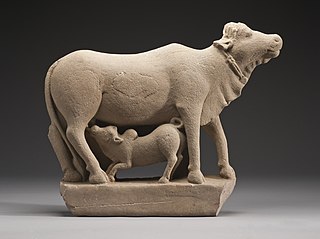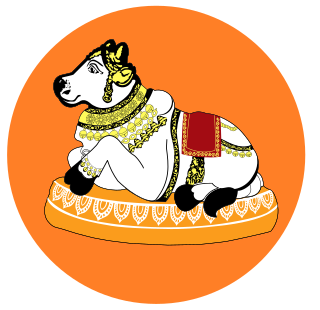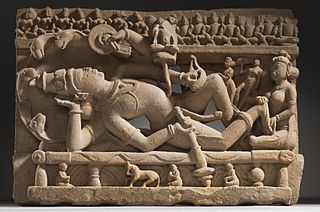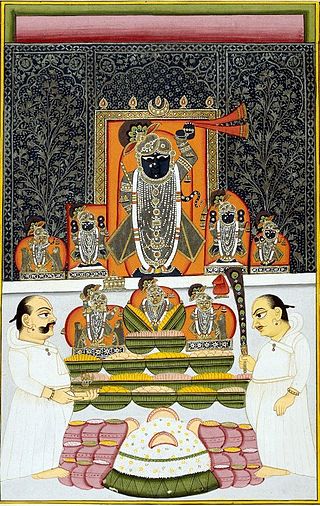
There are varying beliefs about cattle in societies and religions.

Kamadhenu, also known as Surabhi, is a divine bovine-goddess described in Hinduism as the mother of all cows. She is a miraculous cow of plenty who provides her owner whatever they desire and is often portrayed as the mother of other cattle. In iconography, she is generally depicted as a white cow with a female head and breasts, the wings of a bird, and the tail of a peafowl or as a white cow containing various deities within her body. Kamadhenu is not worshipped independently as a goddess. Rather, she is honored by the Hindu veneration of cows, who are regarded as her earthly embodiments.
Agrahayana or Margashirsha, is the ninth month of the Hindu calendar. In India's national civil calendar, Agrahayana is also the ninth month of the year, beginning on 16 November and ending on 15 December. Margashirsha means related to the Mrigashīrsha nakṣatra (asterism), which has been known since Vedic times.
Vrata is a Sanskrit word that means "vow, resolve, devotion", and refers to pious observances such as fasting and pilgrimage (Tirtha) found in Indian religions such as Hinduism and Jainism. It is typically accompanied with prayers seeking health and happiness for their loved ones.

Tihar is a five-day spiritual and cultural Hindu festival of lights celebrated by Nepalese as well as by the Indian Gorkhas inhabiting Sikkim state and Territories. Tihar is analogous to the Indian festival of Diwali, the festival of lights, but both are different Festival.

The Puṣṭimārga, also known as Pushtimarg or Vallabha Sampradāya, is a sect within the Vaishnavism tradition of Hinduism. It was established in the early 16th century by Vallabha (1479–1530) and further developed by his descendants, particularly Viṭṭhalanātha. Followers of the Puṣṭimārga worship Kr̥ṣṇa and engage in devotional practices centered around the youthful Kr̥ṣṇa as depicted in the Bhāgavata Purāṇa, and the pastimes at Govardhan Hill.

Ananta Chaturdashi is a festival dedicated to Vishnu, observed and celebrated by Hindus. It is marked on the fourteenth day of the moon's waxing phase during the Hindu month of Bhadrapada. According to the Agni Purana, the Ananta manifestation of Vishnu is venerated on this occasion to free adherents from sins.

Ekadashi is the eleventh lunar day (tithi) of the waxing and waning lunar cycles in a Vedic calendar month. Ekadashi is popularly observed within Vaishnavism one of the major paths within Sanatan Dharma. Followers offer their worship to the god Vishnu by fasting or just symbolically; the idea was always to receive self-discipline and the benefits of fasting and it was connected to the way of life via Sanatam Dharma practices.

Chaturthi refers to the fourth day of a lunar fortnight in the Hindu calendar.
Swarna Gauri Vrata, also called Gauri Habba is a Hindu festival celebrated a day before Ganesh Chaturthi in Karnataka.

Pradosha or Pradosham is a bimonthly occasion on the thirteenth day (Trayodashi) of every fortnight in the Hindu calendar. It is closely connected with the worship of the Hindu god Shiva. The auspicious three-hour period 1.5 hours before and after sunset is considered as the most suited and optimal time for worship of Shiva on this day. The fasting vow performed during the period is called "Pradosha vrata". A devotee should wear rudraksha, Vibhuti and worship Shiva by abhisheka, sandal paste, bael leaves, fragrance, deepa and naivedya.

Shayani Ekadashi, also known by various other names, is the eleventh lunar day (Ekadashi) of the bright fortnight of the Hindu month of Ashadha. This occasion is holy to Vaishnavas, the followers of the Hindu preserver deity, Vishnu, as it is regarded to be the day the deity's sleep commences.

Govardhan Puja, also known as Annakut or Annakoot, is a Hindu festival celebrated on the first lunar day of the bright fortnight of the month of Kartika, on the fourth day of Diwali. Devotees worship Govardhan Hill and prepare and offer a large variety of vegetarian food to Krishna as a mark of gratitude. For Vaishnavas, this day commemorates the incident in the Bhagavata Purana when Krishna lifted Govardhan Hill to provide the villagers of Vrindavan shelter from torrential rains. This incident symbolizes God offering protection to devotees who take singular refuge in him. Devotees offer a mountain of food, metaphorically representing the Govardhan Hill, to God as a ritual remembrance and to renew their faith in taking refuge in God. The festival is observed by most Hindu denominations all over India and abroad.

Sankashti Chaturthi, also known as Sankatahara Chaturthi and Sankashti, is a holy day in every lunar month of the Hindu calendar dedicated to the Hindu god Ganesha. This day falls on the fourth day of the Krishna Paksha. If this Chaturthi falls on a Tuesday, it is called Angaraki Sankashti Chaturthi, Angaraki Chaturthi, Angaraki and Angarika. Angaraki Sankashti Chaturthi is considered highly sacred.
Dwadashi, also rendered Dvadashi, is the twelfth lunar day (tithi) of the shukla (bright) or krishna (dark) fortnight, or Paksha, of every lunar month in the Hindu calendar.

The Thiru Aadanoor or the Andalakkum Aiyan Perumal Temple is a Hindu temple dedicated to Vishnu located in Aadanoor, Thanjavur district in Tamil Nadu, India. Constructed in Dravidian style of architecture, the temple is glorified in the Nalayira Divya Prabandham, the early medieval Tamil canon of the Alvar saints from the 6th–9th centuries CE. It is counted as one among the 108 Divya Desams dedicated to Vishnu. Vishnu is worshipped as Andalakkum Aiyan and his consort is worshipped as Ranganayaki, a form of Lakshmi.

Amalaka Ekadashi or Amalaki Ekadashi is a Hindu holy day, celebrated on the 11th day (ekadashi) of the waxing moon, in the lunar month of Phalguna (February–March). It is a celebration of the amalaka or amla tree, known as the Indian gooseberry.

Nirjala Ekadashi is a Hindu holy day falling on the 11th lunar day (ekadashi) of the waxing fortnight of the Hindu month of Jyeshtha (May/June). This ekadashi derives its name from the water-less (Nir-jala) fast observed on this day. It is considered to be the most austere and hence the most sacred of all 24 ekadashis. If observed religiously, it is said to be the most rewarding and granting the virtue gained by the observance of all 24 ekadashis in the year.

Mokshada Ekadashi is a Hindu holy day, which falls on the 11th lunar day (ekadashi) of the fortnight of the waxing moon in the Hindu month of Margashirsha (Agrahayana), corresponding to November–December. Hindus, particularly Vaishnavas, observe a 24-hour fast in honour of the deity Krishna, an avatar of Vishnu.

Gopashtami is a Hindu festival occurring on Ashtami of Shukla Paksha of Kartik month, in which cows and bulls are rendered worship. It is the coming-of-age celebration when Krishna's father, Nanda, gave Krishna the responsibility for taking care of the cows of Vrindavan.

















